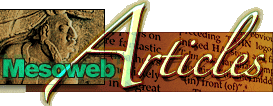

|
The oldest mentions of Uxmal that survive as documents hark to the early days of the Colonial period. The most important indigenous references to the site appear in the Chilam Balam prophetic books which, even though written in Colonial years and in Latin characters, have their direct antecedent in Pre-Columbian-era literature. The oldest Spanish chronicle making reference to Uxmal is the Relación de Tib y Tek, which is a part of the Relaciones histórico-geográficas de Yucatán, which was prepared by official request of the Spanish king Phillip II in 1577. A famous chronicler of the early years of the Colonial period, Antonio de Ciudad Real, also mentions Uxmal in his Tratado curioso y docto de las grandezas de la Nueva España. Fray Antonio visited the site in 1588 in his official capacity as relator for the ecclesiastical commissioner, Fray Alonso Ponce, and his description of the ruined city is by far the vastest and best detailed account of it coming from those days.
For the next, albeit brief reference to Uxmal, we have to wait until 1639, when Pedro Sánchez de Aguilar publishes his Informe contra idolorum cultores. Towards the end of the XVII Century, in his Historia de Yucatán, fray Diego López de Cogolludo publishes a description of the ruins of Uxmal mentioning, for the first time, the popular names given to some of the buildings, names which have survived to this day. A century and a half go by until new mention of the site can be found. The nineteenth century brings on the great era of exploration of countless ancient cities that had lain forgotten for centuries in the Central American jungles. The accounts written by the explorers of these ruins are full of romance and adventure and, with few exceptions, are characterized by their inaccuracy and wild speculative nature. Among the most notable accounts from this era are Picturesque Travel to Yucatan by Friedrich von Waldeck, published in 1838. Emmanuel de Friedrichstal published Les monuments de Yucatan in 1841. The most important and serious account from these years is, doubtless, John L. Stephens' and Frederick Catherwood's Incidents of Travel in Central America, Chiapas and Yucatan, published in 1841, followed shortly thereafter (1843) by their account of a second trip, published under the title Incidents of Travel in Yucatan. These two works are invaluable because Stephens and Catherwood not only discovered and described an inordinate amount of ancient cities (to this day, they probably deserve credit as the discoverers of the most sites ever), but they also painstakingly recorded buildings and monuments, including measurements and orientations. Also, Frederick Catherwood's were the first professional illustrations of what they saw, bringing to the world the first faithful records of ancient Maya art and architecture. This level of accuracy meant travelling for months in the harshest conditions imaginable, working for hours under the merciless tropical sun, often between bouts of malaria attacks. Other explorers who visited Uxmal during the second half of the nineteenth century include Charles Étienne Brasseur de Bourbourg, the noted French photographer Désiré Charnay, and William Holmes, who published records and comments regarding the site's constructions. Between 1886 and 1892, the Austrian photographer/explorer Teobert Maler worked extensively at the site, producing an insuperable photographic record of many of the site's buildings. Eduard Seler and Sylvanus Morley both published studies of Uxmal at the turn of the twentieth century, although from this moment on, research efforts at the site become more influenced by the work of institutions than by the result of any individual's efforts. In 1927, the Mexican government initiates restoration and conservation efforts, with a view to attracting visitors to the Yucatan. In the 1930s, the University of Tulane's Middle American Research Institute carries out archaeological explorations of Uxmal under the direction of Frans Blom. Among other thing, they drew and measured the main buildings and prepared detailed plans of the Nunnery and the Pyramid of the Magician. They also explored and made general plans of Uxmal and its surrounding area. Between 1937 and 1940, Manuel Cirerol explores the eastern and western stairs of the Pyramid of the Magician, while José Erosa restores and consolidates this structure between 1941 and 1947. In 1941, under the auspices of Washington's Carnegie Institution, Sylvanus Morley carries out archaeological excavations at the Great Pyramid. Between 1941 and 1942, he studied the monuments at the Platform of the Stelae and Uxmal's ballcourt, as well as the Northern Group. He published a part of this research in his grand opus Maya Civilization, in 1946. Another important and very influential work from these years are Tatiana Proskouriakoff's architectural restoration drawings of some of Uxmal's buildings. In 1948, Albert Ruz conducts further work at the ballcourt and between 1951 and 1953 works at the Nunnery, the Pyramid of the Magician, and the Palace of the Governor. Between 1955 and 1973, work at Uxmal continues through the exploration, restoration and consolidation of several structures, such as the Northern and Southern Groups at the Nunnery, the Temple of the Cemetery, the Building of the Turtles and the Great Pyramid. Between 1973 and 1974, Bárbara Konieczna and Pablo Mayer supervise the works necessary for installing the light and sound show at the site, and they also carry out explorations of minor structures close to the Nunnery. Between the late 70s and early 80s, work was carried out for the first time on the settlement pattern(s) of Uxmal, the results of which should shed important light on the social structure of the ancient city. While not strictly work at Uxmal, the work of Paul Gendrop and H.E.D. Pollock should be mentioned here, since Uxmal forms an essential part of their studies, arguments, and conclusions regarding the architecture of the Puuc region, of which Uxmal is the prime example.
|